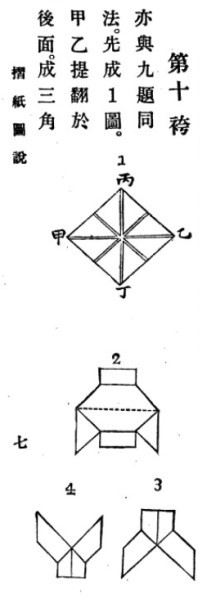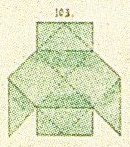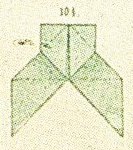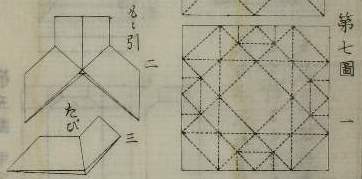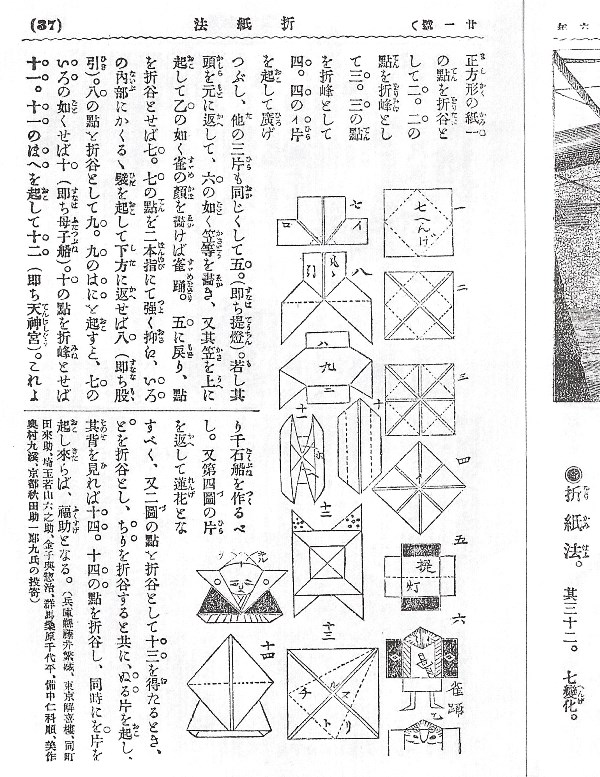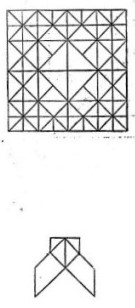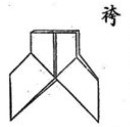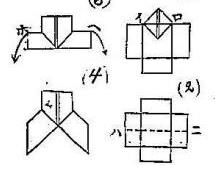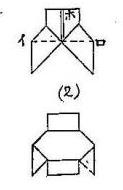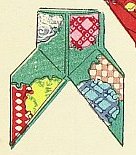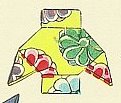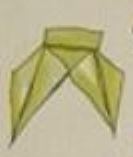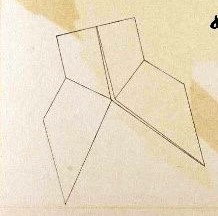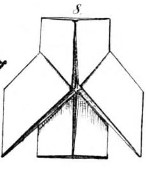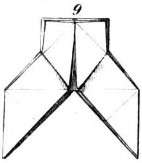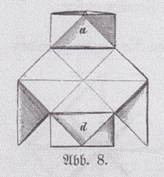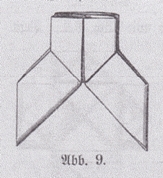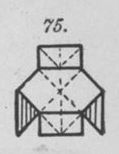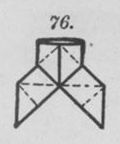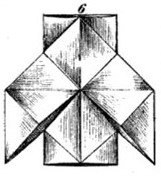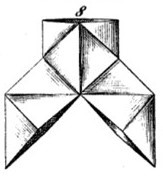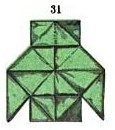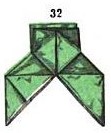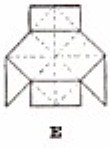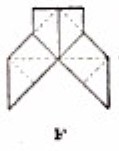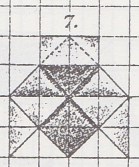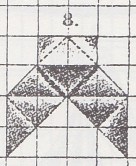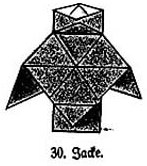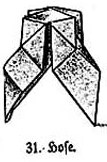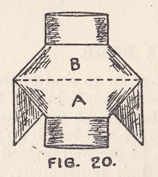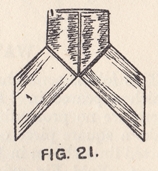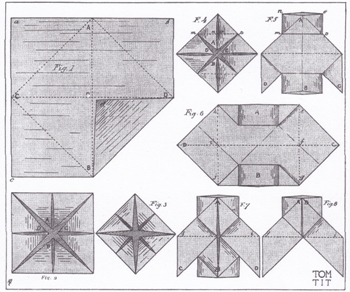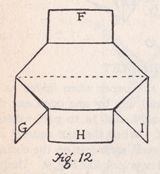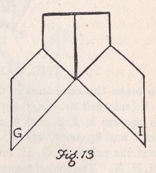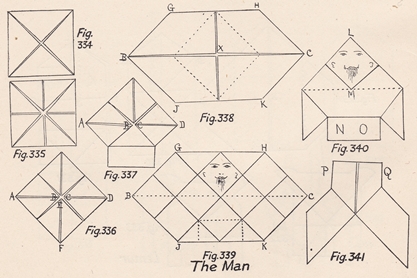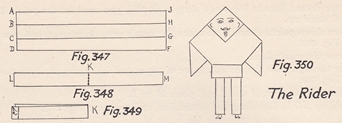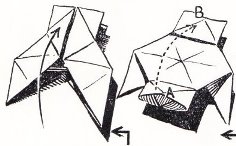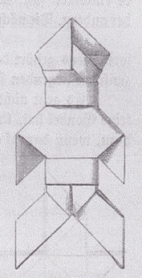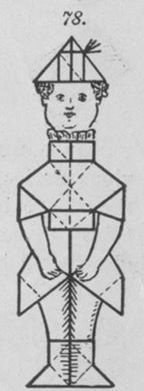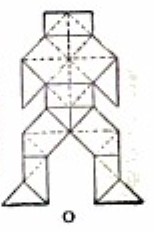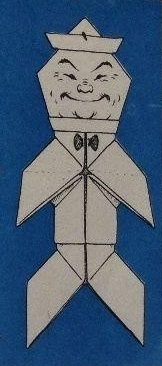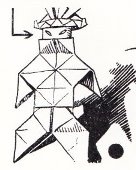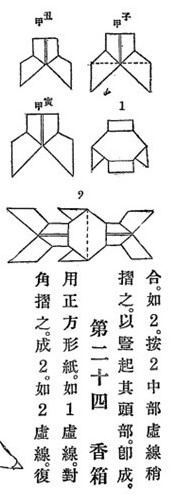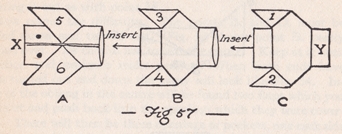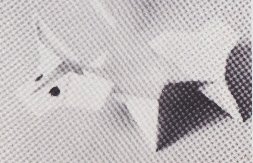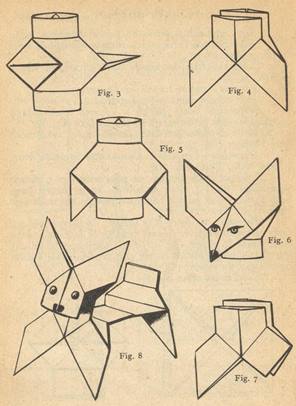| The Public Paperfolding History Project
Last updated 30/4/2024 x |
|||||||
| The Jacket / The Trousers (Hakama) / The Suit of Clothes / The Doll / The Dog | |||||||
| This
page is being used to collect information about the
history of the paperfolding designs known as the Jacket
and the Trousers, both of which are developed from the
Froebelian triple blintz form and which, together, are
sometimes known as the Suit of Clothes, and two
derivative designs, a human figure (The Doll) and an
animal figure (The Dog) made by combining Jackets and
Trousers in various ways. Please contact me if you know
any of this information is incorrect or if you have any
other information that should be added. Thank you. ********** The Jacket and Trousers (aka the Suit of Clothes) In China (and in publications by Chinese authors) 1914 Diagrams for the 'Trousers' appear in 'Zhe zhi tu shuo' (Illustrated Paperfolding), compiled by Gui Shaolie, which was published by the Commercial Press in Shanghai in Ming guo 3 (1914). The Jacket is illustrated as part of the folding sequence but not mentioned as a design in its own right.
********** In Japan (and in publications by Japanese authors) 1878 Both designs appear in 'Yochien Ombutsu No Zu', a publication of kindergarten material issued by the Tokyo Women's Normal School in 1878.
********** 1884 A drawing of the Trousers, but here called 'momohiki', which are a kind of warm underwear similar to 'long johns' worn under a kimono, and a crease pattern appeared in 'Kindergarten Shoho' (Preliminary Kindergarten) by Iijima Hanjuro, which was copyrighted on October 4th Meiji 17 (1884) and published by Fukuda Senzo in August of Meiji 18 (1885).
********** 1894 The Trousers appear as 'Momohiki' (a type of leggings worn by workers) in an article in issue 1984 / 21 of the Japanese children's magazine 'Shokokumin'. There is also a drawing of the Jacket but, here, this is not being presented as a design in its own right but simply as an intermediate step.
********** 1903 A creases pattern and illustration of the Trousers appear in 'Shukouka no Liron Oyobi Jissai' (Handicraft Theory and Practice) by Kuniho Nakamura and Shinpei Ito, which was published by Kofukan in Tokyo in 1903.
********** 1905 A picture of the design appears, as the Trousers, in 'Shukouka Kyohon : Liron Jishuu Souga Setsumei' by Kikujiro Kiuchi, Rokushiro Uehara and Hideyoshi Okayama, which was published by Shigebei Takase in Chiba in 1905.
********** 1908 Diagrams that show how to convert the Yakko-san into the Trousers appear in 'Origami zusetsu' (Illustrated Origami) by Sano Shozo, which was published in Tokyo in 1908.
The Trousers are then converted in the Jacket (called the Goblin Lantern here).
********** 1912 A drawing of both the Jacket and the Trousers appears in a monozukushi-e print, by an unknown artist, but said to be from the Meiji era. I have temporarily assigned it the date of 1912, the last year of that era, pending the discovery of more accurate information.
********** 1927 There is an illustration in a 1927 issue of the children's magazine 'Kodomo No Kuni' (The Land of Children) which may be intended to be a representation of the Trousers.
********** 1935 'Origami Moyo, Book One', by Kawarazaki Kodo, which was published by Unsodo in Japan in 1935, contains a print showing thge Trousers.
********** In Europe and the Americas 1859 The Jacket (La veste du mineur) and the Trousers (Le pantalon) both appear in a list of designs in the 'Manuel Pratique de Jardins D'Enfants de Friedrich Froebel', which was compiled by J F Jacobs and published in Brussells and Paris in 1859. ********** 1863 The earliest known illustrations of the Jacket, as 'Het visschersbuis' (the fisherman's top), and the Trousers, as 'De visschersbroek' (the fisherman's pants), are found in 'De Kleine Papierwerkers 1: Wat men van een stukje papier al maken kan: Het vouwen' (The Small Paperwork 1: What one can make from a piece of paper: Folding) by Elise Van Calcar, which was published by K H Schadd in Amsterdam in 1863.
********** 1869 A design called 'Die Beinkleider' (the trousers), which is not illustrated, but which from the context is most probably the Trousers, appears in a list of designs in 'Der Kindergarten' by Hermann Goldammer, which was published by Habel in Berlin in 1869. ********** 'Paradise of Childhood' by Edward Wiebe, which was published by Milton, Bradley and Company in Springfield, Massachusetts in 1869, and is effectively a translation of Goldammer's 'Der Kindergarten', similarly includes 'pantaloons' in its list of Forms of Life. ********** 1873 Both designs in 'Die Praxis Des Kindergartens' by Auguste Koehler, which was published by Herman Bohlau in Weimar in 1873, as 'Kinderjade' and 'Kinderhose'.
********** 1874 Both the Jacket and the Trousers are pictured in the revised version of 'Der Kindergarten' by Hermann Goldammer which was published by Carl Babel in Berlin in 1874.
********** 1876 The Jacket and Trousers also appear in 'Des Kindes Erste Beschaftigungsbuch' by E Barth and W Niederley, which was first published in Bielefeld and Leipzig, and the foreword of which is dated October 1876.
********** 1877 Both designs also appears, as 'The Jacket with Sleeves and the Children's Trousers', in 'Kindergarten Practice' by Mary Gurney, which is a substantially abridged version, in two parts, of 'Die Praxis Des Kindergartens' by Auguste Koehler. The second part, 'Froebel's Plane Surfaces', contains sections dealing with paper folding, cutting and weaving. The date of the first edition is not known. The second edition was published in 1877 in London by A N Myers and Co.
********** 1880 The Jacket (without the Trousers) appears in 'The Kindergarten Principle' by Mary J Lyschinska was published in London in 1880 by Wm Isbister Ltd.
********** 1882 Both designs appear in part two of 'The Kindergarten Guide' by Maria Kraus Boelte and John Kraus, which was probably first published by E. Steiger and Company in New York in 1882, as 'The Vest' or 'The Jacket' and 'The Pair of Pants'.
********** 1883 As 'Eine Jade' and 'Eine Hose' in 'Der Kindergarten' by A S Fischer, which was published by Alfred Holder in Wien in 1883.
********** 1887 Both designs appear, as ' Knabenjade' (boy's jacket) and 'Knabenhose' (boy's pants) in part 2 'Die Praxis' of 'Theoretisches und praktisches Handbuch der Fröbelschen Erziehungslehre' by Bertha von Marentholtz-Bülow, which was published by George H Wigand in Kassel in 1887.
********** 1890 Diagrams for 'Une culotte' appear in 'Les travaux manuels a l'ecole primaire a l'usage des ecoles de garcons' by Dauzat and Deramond, which was published by Alcide, Picard et Kaan in Paris in 1890.
********** 1891 The same designs that appeared in 'Des Kindes Erste Beschaftigungsbuch' also appear in 'Pleasant Work for Busy Fingers' by Maggie Browne, which was published by Cassell and Company in London in 1891, which is an English adaptation and extension of the earlier work. ********** 1893 'Practical Suggestions for Kindergartners, Primary Teachers and Mothers' by Jeannette R Gregory, which was published by C B Woodward and Co in St Louis in 1893, contains illustration of both the Jacket (as the Waist) and the Trousers.
********** 1896 Both the Jacket and the Trousers are pictured, but not named in Eleonore Heerwart's 'Course in Paperfolding', which was first published in Dutch in 1895 then in English by Charles and Dible in London and Glasgow in 1896.
********** Either or both also appear: 1910 As 'Jacke' (jacket) and 'Hose' (trousers) in Part 2 'Das Flechten' of 'Die Frobelschen Beschaftigungen' by Marie Muller-Wunderlich, which was published by Friedrich Brandstetter in Leipzig in 1910.
********** As 'A Jacket' in 'Handicraft in the School', which was issued in four volumes by Gresham Publishing in London in 1910.
********** 1923 In 'More Paper Magic' by Will Blyth, which was published by C Arthur Pearson in London in 1923.
********** 1924 In 'Joujoux En Papier' by Tom Tit, which was published in Paris by Paul Lechevalier in 1924, as 'Des Bonhommes'.
********** 1928 In 'Fun with Paperfolding' by William D Murray and Francis J Rigney, which was published by the Fleming H Revell Company, New York in 1928.
********** 1936 In 'Paper Toy Making' by Margaret Campbell, which was first published by Sir Isaac Pitman and Sons Ltd in London, probably in 1937, although both the Foreword and Preface are dated 1936, which argues that the book was complete at that date.
The same book also contains 'The Rider', a development of the Jacket.
********** 1956 In 'Paper Magic' by Robert Harbin, which was published by Oldbourne in London in 1956
********** The Doll 1876 As far as I know a version of the Doll first appears in 'Des Kindes Erste Beschaftigungsbuch' by E Barth and W Niederley, which was published in Bielefeld and Leipzig, and the foreword of which is dated October 1876. It is made by combining the Mitre with the Jacket and Trousers to create a human figure.
********** 1882 Another version of the Doll appears in part two of 'The Kindergarten Guide' by Maria Kraus Boelte and John Kraus, which was probably first published by E. Steiger and Company in New York in 1882.
********** 1887 In the introduction to an article on folding 'Nantucket Sinks' (Sanbos on Legs) in the August 1887 issue of the American children's magazine St Nicholas the writer says 'I have seen people with their skillful fingers make a wonderful outfit, raised to dignity by the great name of Napoleon.' This may possibly be a reference to the Doll. ********** 1893 'Practical Suggestions for Kindergartners, Primary Teachers and Mothers' by Jeannette R Gregory, which was published by C B Woodward and Co in St Louis in 1893, contains a version of the Doll made by combining the Jacket, Trousers and two Pairs of Boots. The text says 'Paste picture of boy's head and add cap.'
********** 1951 A version of the design wearing a Paper Boat Hat appears in the 1951 Rupert Annual under the title 'How To Make A Paper Man'.
********** 1956 A version of the Doll appears as 'The Japanese Warrior' in 'Paper Magic' by Robert Harbin, which was published by Oldbourne in London in 1956. The warrior is wearing a Kabuto. The face of the Warrior is a simple paper tube.
********** The Dog The Dog is a modular design made from three pieces, the Jacket and the Trousers, which together form the front and back legs, and a head developed from a similar configuration of folds. In China (and in publications by Chinese authors) 1917 A three-paty design for a 'Tiger', made by combining a Jacket and two pairs of Trousers, appears in 'Xu Zhe zhi tu shuo' (More Illustrated Paperfolding) by Yongxiang Shi, which was published by the Commercial Press in Shanghai in 1917.
********** In Western Europe and the Americas 1928 As far as I know the Dog ( first appears in 'Fun with Paperfolding' by William D Murray and Francis J Rigney, which was published by the Fleming H Revell Company, New York in 1928.
********** 1949 The same design appears as 'Le Chien' (or with a slight variation to the head as 'Le Reynard') in 'Au Pays des Mains Agiles', which was published by Editions Fleurus in Paris in 1949.
********** |
|||||||
